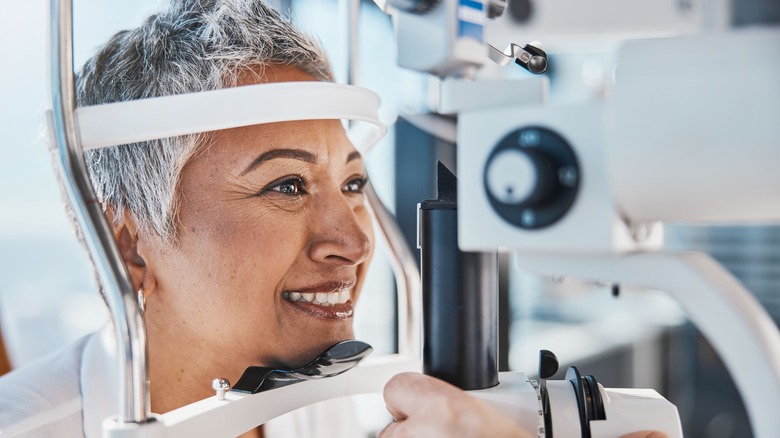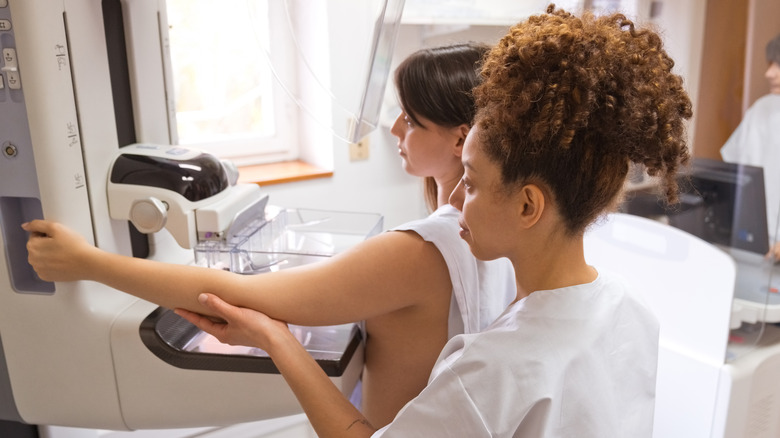Types Of Cancer Your Eyes Can Help Diagnose
They say that the eyes are "the windows to the soul," but perhaps they should more accurately be referred to as "the windows to our health." Our eyes can tell us a lot about our body beyond just the quality of our vision. They can also provide us with clues as to whether we may have Lyme disease, diabetes, high cholesterol, or certain sexually transmitted infections (STIs), reports the American Academy of Ophthalmology. Our eyes may also help healthcare providers detect warning signs of certain cancers.
Squamous cell, basal cell, and melanoma are three types of skin cancer our eyes can help diagnose because they impact the eyelid and outer eye area. According to 2013 research published in the Annals of Saudi Medicine, cases of basal cell carcinoma and squamous cell carcinoma are more common around the world, but melanoma is thought to potentially be more dangerous. People with melanoma of the eye may experience changes in eye color, pain, redness, or bulging of the eyes. Because it is uncommon for melanoma to first develop in the eye, experts at Mount Sinai explain that ocular symptoms such as these may be indicative of existing melanoma in the skin or elsewhere in the body that has now spread to the eye.
How our eyes may help diagnose certain blood cancers
Our eyes may also help diagnose certain types of blood cancers, specifically lymphoma and leukemia (via American Academy of Ophthalmology). Lymphoma is characterized by cancerous growth within the white blood cells. When this occurs in the cells of the retina, it's known as primary intraocular lymphoma (PIOL), explains Columbia University Irving Medical Center. In 80% of cases, the disease affects both eyes, and symptoms may include blurred vision, floaters in one's line of sight, swelling, or sensitivity to light. An eye exam and a biopsy of the cells inside the eye fluid can confirm a diagnosis.
Our eyes may also issue early warning signs of leukemia. In a 2020 study in Pakistan published in the scientific journal Cureus, researchers found that out of nearly 100 people diagnosed with leukemia, over 50 detections of eye-related symptoms were observed in approximately half the patients. Among the more common symptoms were impaired vision and redness. Symptoms were more often seen in patients newly diagnosed with leukemia. Based on these findings, the researchers concluded that the eyes may aid in early cancer detection efforts.
How breast cancer can affect the eyes
For people with breast cancer, the cancer is most likely to spread to the eyes more than anywhere else in the body, explains Moreland EyeCare. Initially, this tumor growth doesn't cause any noticeable symptoms, so the only way to detect the disease is through a dilated eye exam. By the time a tumor starts to affect one's vision, the cancer is often in the later stages of the disease.
Eye exams are important for all of us, but they are particularly important after receiving a breast cancer diagnosis. Our eyes may also be subject to a number of side effects from breast cancer treatment medications, including itching, burning sensations, redness, floaters, watery eyes, pain, or double vision. To help reduce the severity of side effects, try not to rub your eyes and refrain from using contact lenses for the duration of treatment. Use of artificial tears throughout the day, as well as regular hand-washing, can also help provide symptom relief.



